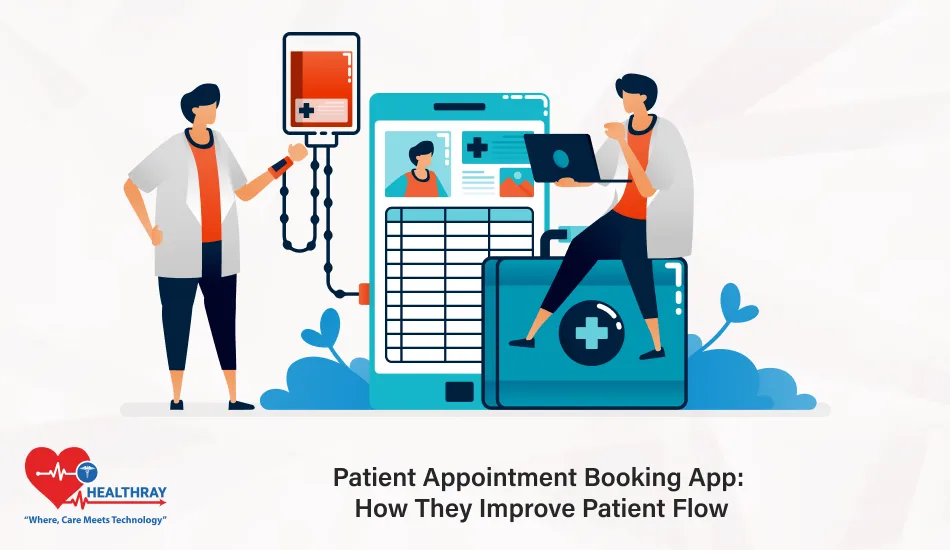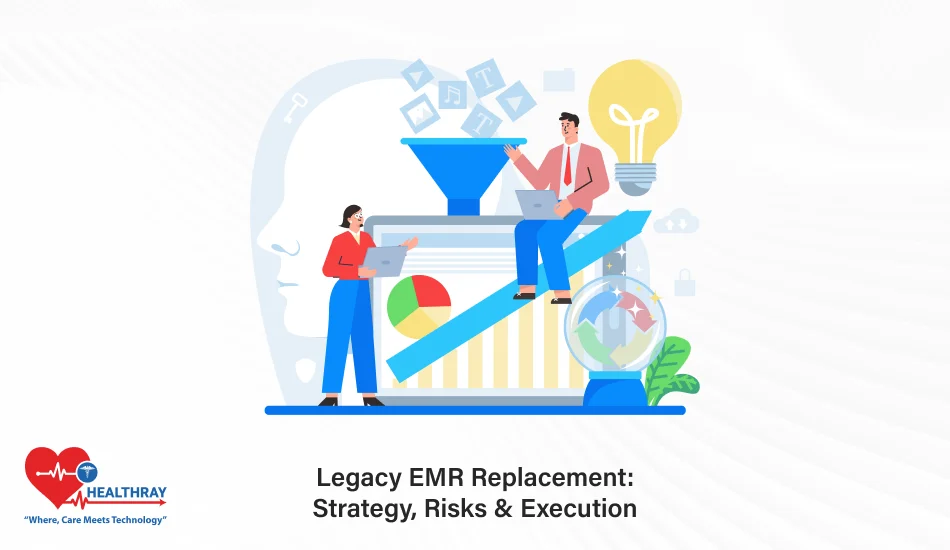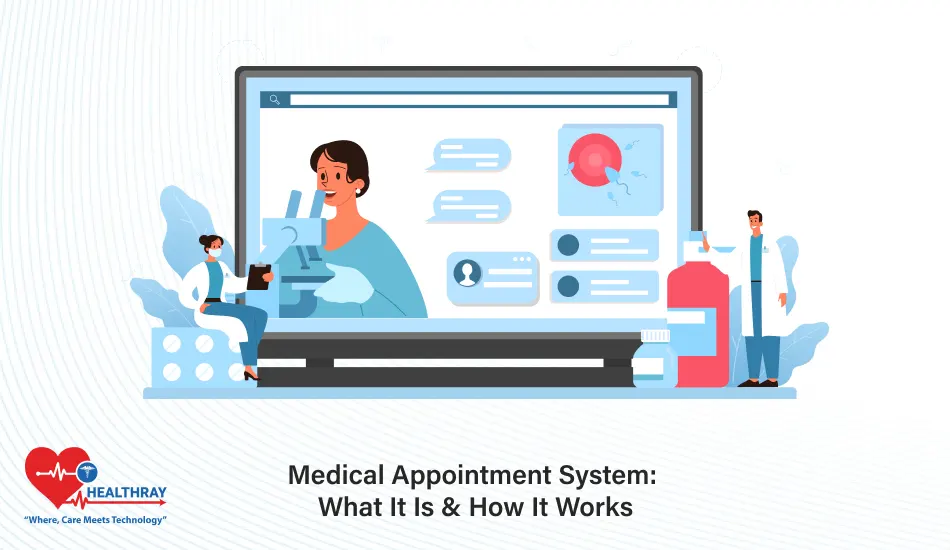One of the greatest challenges for any healthcare facility is the proper management of its outpatient departments. Long waiting times, inefficient appointment systems, and outdated record-keeping frustrate both patients and staff alike, which is where the OPD management software plays its role.
The right software is more than streamlining operations; it changes the patient experience: it reduces waiting, simplifies the process of registration, and allows medical records, always be present. Choosing the best OPD management software is no more a luxury but an essentiality for hospital administrators, clinic owners, and healthcare IT managers.
In the given article, we will discuss the top features to look out for in the OPD management software and how these can bring a considerable improvement in patient satisfaction. Be it upgrading your present system or implementing it for the very first time, the following insights will lead you to the right choice.
Top OPD Management Software Solutions
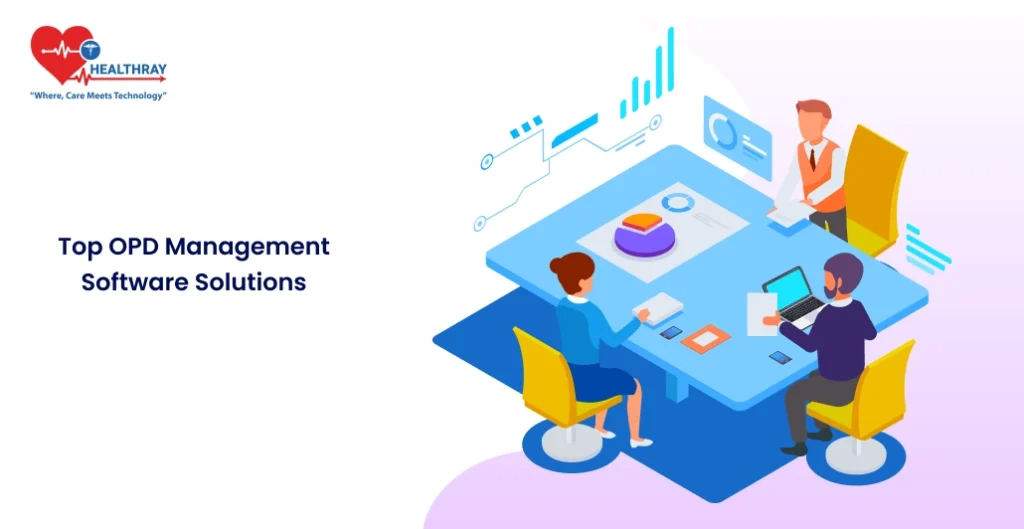
The market has several options when it comes to the selection of OPD management software. Each solution has a bundle of features that enable smooth workflow and better interaction with patients. Here are some of the best options available:
- Healthray Technologies
- Known for an intuitive interface and advanced appointment scheduling features.
- Offers seamless integration with electronic health records.
- EMRSoftware.AI
- Provides advanced analytics to optimize the OPD operations.
- Includes a module on telehealth remote consultations.
- Bigscal Technologies
- Cloud-based solutions specialist: your data is available anytime, anywhere.
- Provides automated queue management to minimize the number of hours patients have to wait.
It is a set of software solutions that help mitigate some of the major challenges in OPD management without compromising on anything related to the patient experience. Be it wait time reduction or data security enhancement, there’s something for everyone.
Important Features to Improve Patient Experience
Before getting into details of functionalities, just remember, using OPD software is easy; you may make it tough by choosing the wrong software. Successfully implemented OPD management software will help in addressing patient needs and smooth administrative tasks. Following are the key features that will directly contribute to improving the patient experience.
Appointment Scheduling
Scheduling plays an important role in minimizing waiting times. In this respect, automated systems provide the facility for patients to schedule, reschedule, or cancel appointments online. This feature ensures fewer overlaps and a smooth patient flow.
Queue Management
Nobody likes waiting. Queue management systems keep patients informed about their waiting time estimates in real time and schedule consultations effectively. Consequently, patients can plan their arrival better, thus reducing frustration.
Integration of Electronic Health Records
Having all patients’ data on one platform speeds up the consultations. A doctor can view medical history, lab reports, and previous prescriptions for informed decisions and quicker treatment.
Patient Registration
Smoothening of the registration processes means that the patient spends less time filling in forms. Digital registration captures all the information required with efficiency and security, cutting down on human error.
Billing and Invoicing
Clear and transparent billing means clarity to the patient. Software with automated invoicing reduces errors and speeds up payment processing, thereby helping to build patients’ trust.
Patient Access Portal
The ease of access by patients to records, prescriptions, and test results over the internet reduces reliance on requests by administrative staff for such information.
Telemedicine Capabilities
The biggest game-changer has been the virtual consults. Patients can now consult with doctors from the comfort of their homes, thus avoiding travel time while increasing access to care.
Multi-Language Support
Multi-language options mean a lot for facilities serving more diverse communities, helping to remove many barriers. It helps all the patients be at ease and feel understood.
Analytics and Reporting
It means that patients benefit when health care practitioners apply data-driven insights in pursuit of operational efficiencies. Appointment trend reporting, patient feedback, and bottlenecks in service all facilitate continuous improvement.
Mobile Accessibility
Mobile-friendly systems enable patients to book appointments, receive notifications, and communicate with staff while on the go, ensuring engagement and convenience for the more technologically savvy.
These features, put together, enable a seamless and truly patient-centered OPD experience. The implementation of such software capability not only enhances operational efficiency but also helps create patient loyalty by placing their needs first.
Benefits of Implementing OPD Management Software
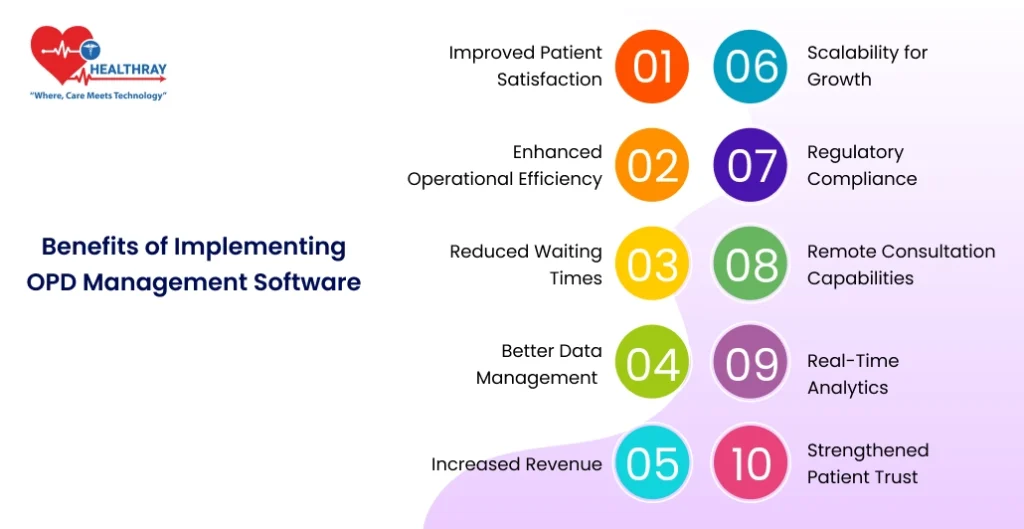
Aside from smoothing the operational multifacetedness, the correct OPD management software addresses pain points specifically for healthcare providers and enhances the patient experience. Some of the key benefits include:
Improved Patient Satisfaction
Efficiency appeals to patients: online booking of appointments, less waiting time, and communication-all these facilitate a smooth, hassle-free experience for the patient.
Improved Operational Efficiency
Automation decreases the workload of most staff by performing routine activities independently, such as scheduling, billing, and generating reports. Now, it has enabled health teams to emphasize the delivery of better care.
Reduced waiting time
The features that can be incorporated into the system include queue management and pre-registration capabilities that might improve patient flow. This helps reduce waiting time for the patients and also improves overall satisfaction, hence improving the reputation of a clinic.
Better Data Management
Centralized electronic health records ensure that patient information is well-protected and always available during consultations, minimizing errors and assuring better quality care.
More Revenue
This helps the clinics and hospitals maintain a steady cash flow through smooth billing and reduces no-shows. With detailed analytics, new opportunities can be identified to generate more revenue.
Scalability for Growth
Software built with scalability in mind means that the software will grow with you as your practice expands. Whether adding services or locations, the system expands with you.
Regulatory Compliance
Most of the OPD management tools are designed to guarantee adherence to the protection laws regarding healthcare data, thus enabling a decrease in the chances of any legal or financial penalties.
Remote Consultation Capabilities
Telemedicine services provide unparalleled access to patients who cannot make office visits, increasing your reach while improving patient convenience.
Real-time Analytics
Data-driven insights help administrators make informed decisions. Be it finding the peak hours of patients or helping to understand the feedback trends, analytics light the way for continuous improvement.
Improved trust between the patient and the doctor
Trust is built through transparent billing, secure data management, and accessible portals. People have no better way of coming back to you and recommending your services than making them feel cared for and respected.
As a matter of fact, the benefits of the OPD management software go way beyond the operational level. By putting patients first and smoothing the workflows, healthcare facilities can distinguish their care.
OPD Management Software: Points to Consider
Indeed, the selection of appropriate OPD management software is one of the crucial decisions for you which would directly impact operational efficiency and patient satisfaction. If proper selection is done with the right approach and if you find a perfect fit, then working on OPD software becomes quite easy. Here are some of the factors you should consider before making your choice:
Cost and Budget
With regard to the total cost of ownership, consider setup fees, subscription costs, and other additional upgrade or support charges. Make sure it fits in your budget, but don’t sacrifice needed features.
Ease of Integration
It should integrate well into your existing systems, whether it is EHR, a billing platform, or a diagnostic tool. Easy integration at this stage reduces disruptions once the time for implementation arrives.
Ease of use
Opt for a system that boasts a simple interface-one that requires as little training as possible. A complicated system will simply frustrate your employees and be counterproductive in finding a solution to any inefficiencies.
Customization Options
No two healthcare facilities are identical, and this is why your selected software solution should let you customize workflows, reports, and modules in the way that best suits you.
Scalability
As your facility grows, so do your needs. Make sure the software is able to scale up and accommodate more patients, new services, or even additional locations.
Vendor Support
Things like timely resolution of issues do depend a lot upon reliable customer support. Vendors having impeccable credibility are going to have commendable responsiveness, training, and documentation.
Data Security
Patient information should not be compromised at all. The program must regard all healthcare regulations; it should have strict security, updates, and encryption.
Mobile and Remote Access
Additionally, mobile-friendly systems allow staff to easily access patient information on the go, enhancing the remote engagement of patients with services, especially for telemedicine capabilities.
Reporting and Analytics
Advanced analytics will provide insight into both operational trends and patient satisfaction. Be sure the software provides customizable reports that will enable you to monitor performance correctly and make informed decisions.
Vendor Reputation and Reviews
Read through reviews, testimonials, and case studies to estimate the credibility of the vendor. Responses from similar healthcare facilities will help you understand how that particular software fares in real-world scenarios.
The right choice of OPD management software is all about finding a balance between the requirements of your facility, its budget, and the goals in the long run. The time you invest in considering these elements will provide a solution that works not only for your patients but also for your team.
Conclusion
Moreover, the selection of appropriate OPD management software is not just about simplifying the work; rather, it’s about changing the whole premise of how your healthcare facility relates to a patient. The right software ensures that from smooth appointment scheduling to secure access to medical records, there is a place where staff and patients alike can thrive.
From patient satisfaction and staff productivity to facility success in the long term, it’s a far-reaching decision for the hospital administrator, clinic owner, and healthcare IT manager alike. Building trust with your patients through feature priorities-including queue management, telemedicine, and data security-will engender loyalty.
Consider your choice in light of facility needs, scalability of software, and vendor support. Each of these features plays an important role in assuring that the investment translates into measurable gains in efficiency and patient care.
Your patients deserve a seamless and supported experience, and good OPD management software is an extremely powerful tool in making this happen. This is a very good time to look at what works today and determine how these systems can be taken up a notch to meet modern healthcare requirements.


